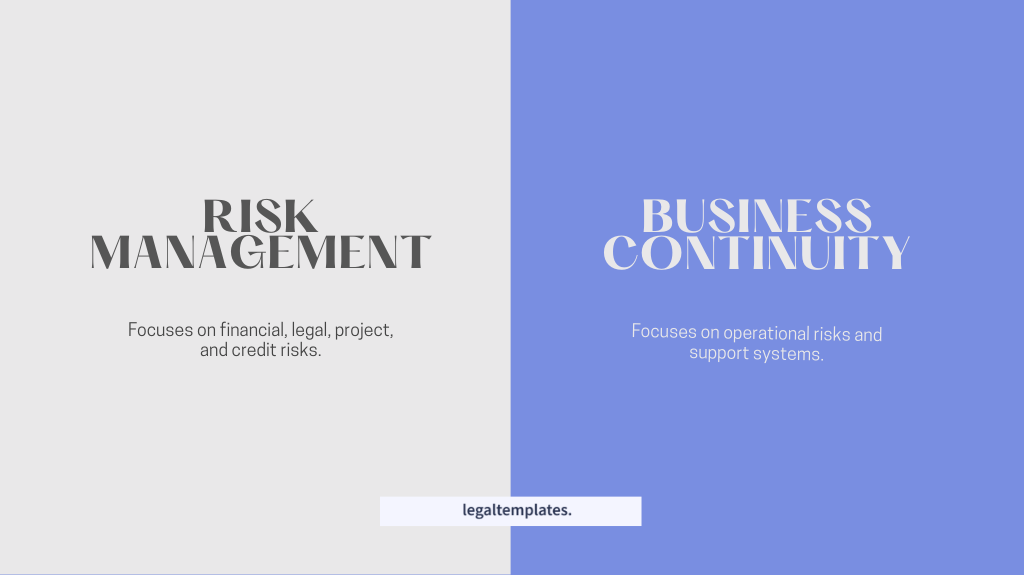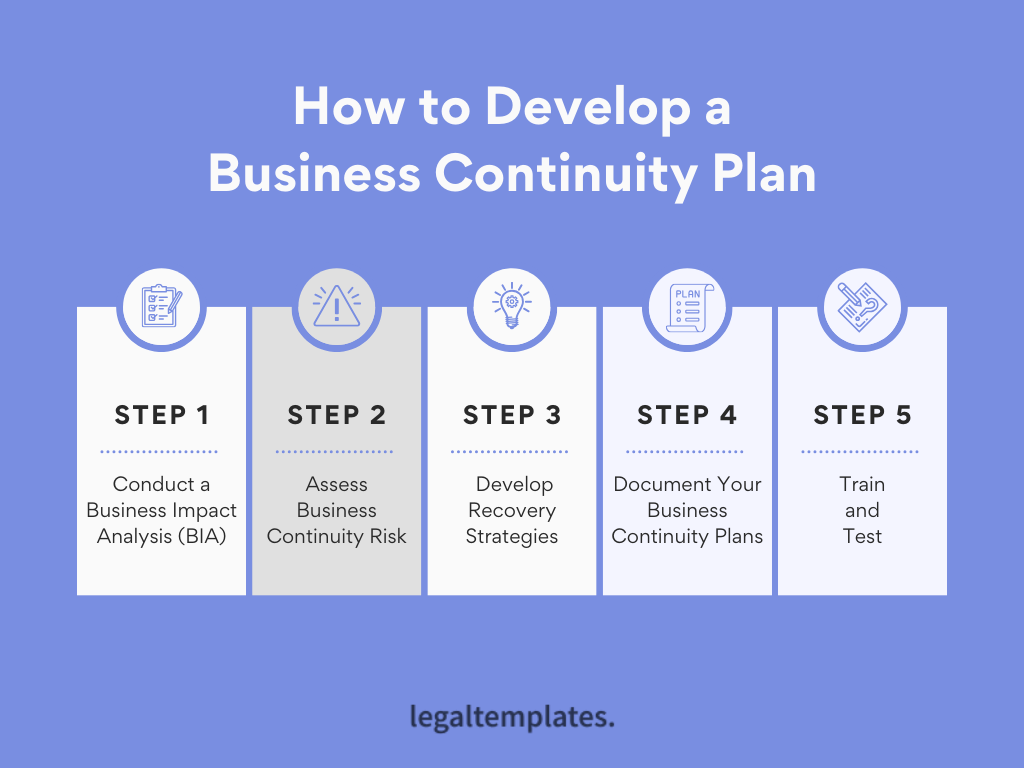
Every business encounters risks such as natural disasters, inflation, employee issues, and market shifts, and must manage the consequences of these potential threats.
Effective risk management and business continuity are essential for any competitive and well-prepared organization.
This article examines how Business Continuity Planning integrates with risk management to protect your enterprise from threats. It highlights their distinct but complementary functions and demonstrates how they work together to strengthen your business against disruptions.
Key Takeaways
- Effective integration of risk management and business continuity planning is crucial for proactive threat management and quick operational recovery.
- Risk management minimizes potential problems, while business continuity planning prepares for worst-case scenarios.
- Both plans should be tailored and regularly updated to stay effective and meet changing needs and challenges.
What Is Risk Management?
Risk management involves a systematic approach to identifying, assessing, and managing various threats that could harm an organization’s financial health, legal standing, strategic direction, and security. These threats can come from many sources, such as financial instability, legal issues, strategic blunders, accidents, or natural disasters.
Consider the consequences if an unexpected event were to strike your business without warning. The impact might be minor, perhaps slightly increasing your overhead costs. However, in severe cases, it could lead to a financial crisis or even force your business to shut down. That’s why risk management is crucial—it uses a proactive approach to reduce both the likelihood and impact of negative events while trying to enhance positive outcomes.
Risk management is not a one-size-fits-all approach. You should:
- Understand the importance of acknowledging the presence of threats
- Complete a thorough risk assessment and determine how threats could impact critical business functions
- Select a risk management strategy that is unique to an organization and prepare for the what ifs
- Develop a business continuity plan to manage or limit consequences if the risk becomes real
What Is a Business Continuity Plan?
A Business Continuity Plan (BCP) is a comprehensive document designed to ensure that a company can continue to operate during and recover from various types of disruptions.
The plan outlines procedures and instructions an organization must follow in the face of disruptive events such as natural disaster, cyber-attacks, power outages, human error, supply chain issues, or other significant threats. Its primary goal is to protect personnel and assets, minimizing any operational downtime and saving company money.
Business Continuity vs Risk Management

Business Continuity Planning is an important part of comprehensive risk management, designed to help an organization recover quickly after disaster strikes. While risk management primarily aims to minimize potential problems from external sources, business continuity planning focuses on preparing for the worst-case scenarios, outlining specific actions a company should take to respond and resume operations .
Common Ground:
- Addressing Uncertainties: Both strategies aim to identify threats and mitigate risks.
- Proactive Measures: They mitigate issues before they occur rather than reacting after the fact.
- Structured Processes: Each requires developing sound recovery strategies.
- Customization: They must be tailored to fit the unique needs and processes of your organization.
- Dynamic and Responsive: Both strategies need to adapt to changes and evolve over time.
- Continuous Improvement: It’s vital to regularly refine and enhance these strategies.
- Value Creation: At their core, both are about safeguarding the organization’s value.
Key Differences:
- Risk Management: Traditionally focuses on financial, legal, project, and credit risks.
- Business Continuity: Concentrates on keeping a company’s operations running during and after a crisis, dealing mainly with operational risks and supporting systems.
To ensure that your organization meets its needs without any planning gaps, it’s crucial to clearly define specific roles, responsibilities, and a reporting structure. This helps in coordinating and integrating both systems effectively, making your organization more resilient and prepared for long term success.
Integrating Risk Management and Business Continuity Plans
In today’s fast-paced and unpredictable business environment, the integration of Risk Management and Business Continuity Plans (BCP) has become essential for organizations across various industries. This integration ensures not only the proactive management of potential risks but also the rapid restoration of operations after any disruption. Here are some examples from various industries
1. Technology Industry: Cybersecurity Threats
- Scenario: A tech company faces the risk of data breaches and cyber-attacks, which can lead to loss of sensitive customer data and reputational damage.
- Risk Management Strategy: The company invests in advanced cybersecurity measures, including regular security audits, employee training on phishing and other cyber threats, and the implementation of robust data encryption and firewalls.
- Business Continuity Planning: In addition to the security measures, the company develops a comprehensive disaster recovery plan, which includes backup and restore procedures to ensure that critical data and systems can be quickly reinstated after a cyber attack. They also establish a business continuity team responsible for maintaining operations during a cyber incident, minimizing downtime and customer impact.
2. Construction Industry: Safety Hazards
- Scenario: Construction sites are prone to various safety risks, such as accidents from machinery, natural disasters, or falls from heights, which can cause serious injuries and lead to costly legal issues and project delays.
- Risk Management Strategy: The construction firm implements a comprehensive safety program that includes regular safety training for all employees, strict adherence to safety regulations, and the use of protective equipment. Routine site inspections ensure compliance and address potential hazards.
- Business Continuity Planning: The firm prepares contingency plans for major accidents, including alternative project schedules and resources to maintain project timelines. They also secure agreements with subcontractors and suppliers to provide immediate support in replacing key personnel or materials, ensuring that project continuity is maintained even after an incident.
3. Retail Industry: Inventory Shrinkage
- Scenario: Retail businesses often face the risk of inventory shrinkage due to theft, employee pilferage, or administrative errors, which can result in significant financial losses.
- Risk Management Strategy: To combat inventory shrinkage, a retail store might use security cameras and anti-theft devices to deter theft. They also implement strict inventory management protocols and conduct regular audits.
- Business Continuity Planning: The retail store establishes protocols to quickly replenish inventory and restore operations in the event of significant losses. This might include arrangements with suppliers for rapid restocking and the use of temporary staff to handle increased workload during recovery periods. Additionally, they maintain an emergency fund to cover unexpected financial losses from shrinkage, ensuring financial stability.
How to Develop a Business Continuity Plan

Ensuring your business can bounce back from unexpected disruptions is crucial. Here’s a simple guide on how to develop a Business Continuity Plan (BCP) that’s both robust and easy to implement:
Step 1: Conduct a Business Impact Analysis (BIA)
- Objective: Figure out which parts of your business need to be up and running no matter what.
- How-To: List down all your business operations in your Business Impact Analysis, pinpoint the critical functions, understand what resources they depend on, and assess how their downtime affects your business.
Step 2: Assess Business Continuity Risk
- Objective: Understand the threats to your business’s smooth operation.
- How-To: Identify potential risks or events that could disrupt your business operations. Consider everything from natural disasters to supply chain disruptions, and then evaluate how likely these are to happen and their potential impact.
Step 3: Develop Recovery Strategies
- Objective: Plan how to keep essential business functions running during a crisis.
- How-To: Use the insights from your BIA and risk assessment to come up with strategies. These could involve having backups for critical resources, alternative working locations, or cloud-based technology solutions to ensure continuity.
Step 4: Document Your Business Continuity Plans
- Objective: Get your plan down on paper.
- How-To: Document all the strategies, procedures, and resources necessary to keep your business running. This should include clear communication plans, key stakeholders, emergency contact numbers, and specific roles and responsibilities for your team.
Step 5: Train and Test
- Objective: Make sure your plan works and everyone knows what to do.
-
How-To:
- Train: Conduct regular training for your team and describe their specific roles in a crisis.
- Test: Regularly simulate different disruption scenarios and test the plan’s effectiveness. Adjust the plan based on these drills to fix any weak spots.
Business Continuity Test Examples
- Tabletop Exercise: Team members role-play their response to a simulated cyber-attack, discussing coordination and decision-making steps without activating real systems.
- Simulation Test: The IT department responds to a mock scenario where the primary data center goes down, testing the effectiveness of data backup and recovery procedures.
- Full Interruption Test: The entire organization switches to operating from a secondary location for a day to test the feasibility and efficiency of working under emergency conditions.
By following these steps, you can create a business continuity plan that not only protects your business during disruptions but also provides peace of mind knowing that you’re prepared for whatever comes your way.
Tips for Successful Risk Mitigation
Your team must practice equitable decision-making when a business develops its risk mitigation strategy and action plan. Here are some tips to make the process solution-based:
Try to...
- Involve Key Stakeholders
Every business depends on people to thrive. The perspectives of stakeholders such as your employees, vendors, suppliers, company leaders, project participants, and even clients are necessary to create a solid mitigation plan. Make sure everyone understands their role in the recovery efforts and are able to respond accordingly.
- Communicate the Value of Risk Management
Management can establish a company culture that identifies high-priority risks and develops disaster recovery plans that ensure rapid recovery. This forward-thinking strategy focuses on establishing and integrating multiple safeguards across the organization’s critical functions and infrastructures.
- Share the Presence of Risks
Any business organization with employees, vendors, and clients should share the presence of risks and how they are being managed. This, too, strengthens the company culture around risk management and its importance. For instance, by exposing the impact of unreliable suppliers on operations, employees could be more incentivized to contract with multiple vendors for critical materials or services
- Establish a Business Continuity Plan
When investing in business continuity management, everyone will reap the benefits. Organizations that invest in risk management develop a Business Continuity Plan that can effectively mitigate risk and are well-prepared to handle any challenges that may arise.
- Monitor Risks
Businesses should consistently monitor the threats associated with their critical functions. By doing so, companies will constantly improve their organizational resilience, business processes, and procedures to stay on top of their operations.
Conclusion
Developing a business continuity plan transcends mere incident prevention and disaster recovery plans; it cultivates a business culture that prioritizes organizational resilience, preparedness, and ongoing improvement.
By embedding these values deeply within the company’s operations, businesses enhance their ability to withstand unexpected challenges and position themselves for sustained success and growth. This proactive approach ensures that the business is not only ready to face current risks but also perpetually evolving to meet the demands of the future.
